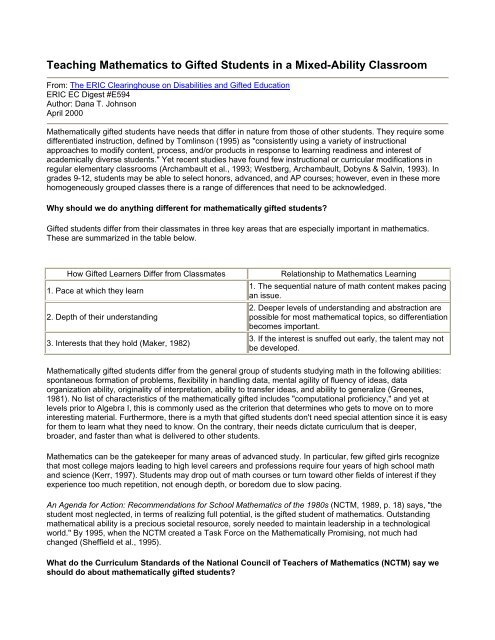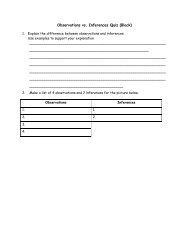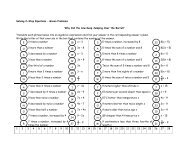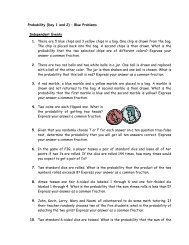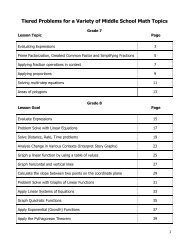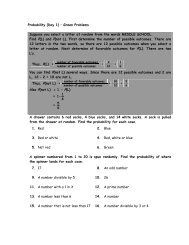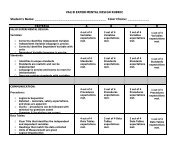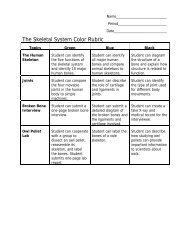Teaching Math to Gifted Students in Mixed-Ability Classes
Teaching Math to Gifted Students in Mixed-Ability Classes
Teaching Math to Gifted Students in Mixed-Ability Classes
Create successful ePaper yourself
Turn your PDF publications into a flip-book with our unique Google optimized e-Paper software.
<strong>Teach<strong>in</strong>g</strong> <strong>Math</strong>ematics <strong>to</strong> <strong>Gifted</strong> <strong>Students</strong> <strong>in</strong> a <strong>Mixed</strong>-<strong>Ability</strong> Classroom<br />
From: The ERIC Clear<strong>in</strong>ghouse on Disabilities and <strong>Gifted</strong> Education<br />
ERIC EC Digest #E594<br />
Author: Dana T. Johnson<br />
April 2000<br />
<strong>Math</strong>ematically gifted students have needs that differ <strong>in</strong> nature from those of other students. They require some<br />
differentiated <strong>in</strong>struction, def<strong>in</strong>ed by Toml<strong>in</strong>son (1995) as "consistently us<strong>in</strong>g a variety of <strong>in</strong>structional<br />
approaches <strong>to</strong> modify content, process, and/or products <strong>in</strong> response <strong>to</strong> learn<strong>in</strong>g read<strong>in</strong>ess and <strong>in</strong>terest of<br />
academically diverse students." Yet recent studies have found few <strong>in</strong>structional or curricular modifications <strong>in</strong><br />
regular elementary classrooms (Archambault et al., 1993; Westberg, Archambault, Dobyns & Salv<strong>in</strong>, 1993). In<br />
grades 9-12, students may be able <strong>to</strong> select honors, advanced, and AP courses; however, even <strong>in</strong> these more<br />
homogeneously grouped classes there is a range of differences that need <strong>to</strong> be acknowledged.<br />
Why should we do anyth<strong>in</strong>g different for mathematically gifted students?<br />
<strong>Gifted</strong> students differ from their classmates <strong>in</strong> three key areas that are especially important <strong>in</strong> mathematics.<br />
These are summarized <strong>in</strong> the table below.<br />
How <strong>Gifted</strong> Learners Differ from Classmates<br />
1. Pace at which they learn<br />
2. Depth of their understand<strong>in</strong>g<br />
3. Interests that they hold (Maker, 1982)<br />
Relationship <strong>to</strong> <strong>Math</strong>ematics Learn<strong>in</strong>g<br />
1. The sequential nature of math content makes pac<strong>in</strong>g<br />
an issue.<br />
2. Deeper levels of understand<strong>in</strong>g and abstraction are<br />
possible for most mathematical <strong>to</strong>pics, so differentiation<br />
becomes important.<br />
3. If the <strong>in</strong>terest is snuffed out early, the talent may not<br />
be developed.<br />
<strong>Math</strong>ematically gifted students differ from the general group of students study<strong>in</strong>g math <strong>in</strong> the follow<strong>in</strong>g abilities:<br />
spontaneous formation of problems, flexibility <strong>in</strong> handl<strong>in</strong>g data, mental agility of fluency of ideas, data<br />
organization ability, orig<strong>in</strong>ality of <strong>in</strong>terpretation, ability <strong>to</strong> transfer ideas, and ability <strong>to</strong> generalize (Greenes,<br />
1981). No list of characteristics of the mathematically gifted <strong>in</strong>cludes "computational proficiency," and yet at<br />
levels prior <strong>to</strong> Algebra I, this is commonly used as the criterion that determ<strong>in</strong>es who gets <strong>to</strong> move on <strong>to</strong> more<br />
<strong>in</strong>terest<strong>in</strong>g material. Furthermore, there is a myth that gifted students don't need special attention s<strong>in</strong>ce it is easy<br />
for them <strong>to</strong> learn what they need <strong>to</strong> know. On the contrary, their needs dictate curriculum that is deeper,<br />
broader, and faster than what is delivered <strong>to</strong> other students.<br />
<strong>Math</strong>ematics can be the gatekeeper for many areas of advanced study. In particular, few gifted girls recognize<br />
that most college majors lead<strong>in</strong>g <strong>to</strong> high level careers and professions require four years of high school math<br />
and science (Kerr, 1997). <strong>Students</strong> may drop out of math courses or turn <strong>to</strong>ward other fields of <strong>in</strong>terest if they<br />
experience <strong>to</strong>o much repetition, not enough depth, or boredom due <strong>to</strong> slow pac<strong>in</strong>g.<br />
An Agenda for Action: Recommendations for School <strong>Math</strong>ematics of the 1980s (NCTM, 1989, p. 18) says, "the<br />
student most neglected, <strong>in</strong> terms of realiz<strong>in</strong>g full potential, is the gifted student of mathematics. Outstand<strong>in</strong>g<br />
mathematical ability is a precious societal resource, sorely needed <strong>to</strong> ma<strong>in</strong>ta<strong>in</strong> leadership <strong>in</strong> a technological<br />
world." By 1995, when the NCTM created a Task Force on the <strong>Math</strong>ematically Promis<strong>in</strong>g, not much had<br />
changed (Sheffield et al., 1995).<br />
What do the Curriculum Standards of the National Council of Teachers of <strong>Math</strong>ematics (NCTM) say we<br />
should do about mathematically gifted students?
The NCTM Standards do not mention gifted students explicitly but recognize that students are not all the same.<br />
For all students, the Standards place a greater emphasis on areas that traditionally have been emphasized for<br />
the gifted. All students are now expected <strong>to</strong> complete a core curriculum that has shifted its emphasis away from<br />
computation and rout<strong>in</strong>e problem practice <strong>to</strong>ward reason<strong>in</strong>g, real-world problem solv<strong>in</strong>g, communication, and<br />
connections. "The Standards propose that all students be guaranteed equal access <strong>to</strong> the same curricular<br />
<strong>to</strong>pics; it does not suggest that all students should explore the content <strong>to</strong> the same depth or at the same level of<br />
formalism" (NCTM, 1989, p. 131). At the high school level, additional <strong>to</strong>pics are suggested for "college<strong>in</strong>tend<strong>in</strong>g"<br />
students. The Report of the Task Force on the <strong>Math</strong>ematically Promis<strong>in</strong>g recognizes that there are<br />
special issues relat<strong>in</strong>g <strong>to</strong> the education of the mathematically promis<strong>in</strong>g student (Sheffield et al., 1995) and has<br />
made recommendations that <strong>in</strong>clude the development of new curricular standards, programs, and materials that<br />
encourage and challenge the mathematically promis<strong>in</strong>g.<br />
What should be done <strong>to</strong> differentiate curriculum, <strong>in</strong>struction and assessment for the mathematically<br />
gifted <strong>in</strong> the regular classroom?<br />
His<strong>to</strong>rically there has been debate about the role of acceleration versus enrichment as the differentiation mode<br />
for mathematics. Most experts recommend a comb<strong>in</strong>ation. The follow<strong>in</strong>g are suggestions for differentiat<strong>in</strong>g for<br />
the mathematically gifted by us<strong>in</strong>g (1) assessment, (2) curriculum materials, (2) <strong>in</strong>structional techniques, and (4)<br />
group<strong>in</strong>g models. These opportunities should be made broadly available <strong>to</strong> any student with <strong>in</strong>terest <strong>in</strong> tak<strong>in</strong>g<br />
advantage of them.<br />
• Give pre-assessments so that students who already know the material do not have <strong>to</strong> repeat it but<br />
may be provided with <strong>in</strong>struction and activities that are mean<strong>in</strong>gful. In the elementary grades, gifted<br />
learners still need <strong>to</strong> know their basic facts. If they do not, don't hold them back from other more<br />
complex tasks, but cont<strong>in</strong>ue <strong>to</strong> work concurrently on the basics.<br />
• Create assessments that allow for differences <strong>in</strong> understand<strong>in</strong>g, creativity, and accomplishment; give<br />
students a chance <strong>to</strong> show what they have learned. Ask students <strong>to</strong> expla<strong>in</strong> their reason<strong>in</strong>g both orally<br />
and <strong>in</strong> writ<strong>in</strong>g.<br />
• Choose textbooks that provide more enriched opportunities. Unfortunately, curriculum <strong>in</strong> this country is<br />
ma<strong>in</strong>ly driven by textbooks, which are used about 80% of the time (Lockwood, 1992). <strong>Math</strong> textbooks<br />
often repeat <strong>to</strong>pics from year <strong>to</strong> year <strong>in</strong> the grades prior <strong>to</strong> algebra. S<strong>in</strong>ce most textbooks are written for<br />
the general population, they are not always appropriate for the gifted. Several series that hold promise<br />
for gifted learners have been developed recently under grants from the National Science Foundation;<br />
they emphasize constructivist learn<strong>in</strong>g and <strong>in</strong>clude concepts beyond the basics.<br />
• Use multiple resources. No s<strong>in</strong>gle text will adequately meet the needs of these learners.<br />
• Be flexible <strong>in</strong> your expectations about pac<strong>in</strong>g for different students. While some may be master<strong>in</strong>g<br />
basic skills, others may work on more advanced problems.<br />
• Use <strong>in</strong>quiry-based, discovery learn<strong>in</strong>g approaches that emphasize open-ended problems with<br />
multiple solutions or multiple paths <strong>to</strong> solutions. Allow students <strong>to</strong> design their own ways <strong>to</strong> f<strong>in</strong>d the<br />
answers <strong>to</strong> complex questions. <strong>Gifted</strong> students may discover more than you thought was possible.<br />
• Use lots of higher-level questions <strong>in</strong> justification and discussion of problems. Ask "why" and "what if"<br />
questions.<br />
• Provide units, activities, or problems that extend beyond the normal curriculum. Offer challeng<strong>in</strong>g<br />
mathematical recreations such as puzzles and games.<br />
• Provide AP level courses <strong>in</strong> calculus, statistics, and computer science or encourage prepared<br />
students <strong>to</strong> take classes at local colleges if the supply of courses at the high school has been<br />
exhausted.<br />
• Differentiate assignments. It is not appropriate <strong>to</strong> give more problems of the same type <strong>to</strong> gifted<br />
students. You might give students a choice of a regular assignment; a different, more challeng<strong>in</strong>g one;<br />
or a task that is tailored <strong>to</strong> <strong>in</strong>terests.<br />
• Expect high level products (e.g., writ<strong>in</strong>g, proofs, projects, solutions <strong>to</strong> challeng<strong>in</strong>g problems).<br />
• Provide opportunities <strong>to</strong> participate <strong>in</strong> contests such as <strong>Math</strong>ematical Olympiads for the Elementary<br />
School (grades 4-6), <strong>Math</strong> Counts (grades 7-8), and the American Junior High School <strong>Math</strong>ematics<br />
Exam (grades 7-8) or the American High School <strong>Math</strong>ematics Exam (grades 9-12). Give feedback <strong>to</strong>
students on their solutions. After the contests, use some of the problems as the basis for classroom<br />
discussions.<br />
• Provide access <strong>to</strong> male and female men<strong>to</strong>rs who represent diverse l<strong>in</strong>guistic and cultural groups.<br />
They may be with<strong>in</strong> the school system, volunteers from the community, or experts who agree <strong>to</strong> respond<br />
<strong>to</strong> questions by e-mail. Br<strong>in</strong>g speakers <strong>in</strong><strong>to</strong> the classroom <strong>to</strong> expla<strong>in</strong> how math has opened doors <strong>in</strong><br />
their professions and careers.<br />
• Provide some activities that can be done <strong>in</strong>dependently or <strong>in</strong> groups based on student choice. Be<br />
aware that if gifted students always work <strong>in</strong>dependently, they are ga<strong>in</strong><strong>in</strong>g no more than they could do at<br />
home. They also need appropriate <strong>in</strong>struction, <strong>in</strong>teraction with other gifted students, and regular<br />
feedback from the teacher.<br />
• Provide useful concrete experiences. Even though gifted learners may be capable of abstraction and<br />
may move from concrete <strong>to</strong> abstract more rapidly, they still benefit from the use of manipulatives and<br />
"hands-on" activities.<br />
How can technology support the needs of the gifted?<br />
Technology can provide a <strong>to</strong>ol, an <strong>in</strong>spiration, or an <strong>in</strong>dependent learn<strong>in</strong>g environment for any student, but for<br />
the gifted it is often a means <strong>to</strong> reach the appropriate depth and breadth of curriculum and advanced product<br />
opportunities. Calcula<strong>to</strong>rs can be used as an exploration <strong>to</strong>ol <strong>to</strong> solve complex and <strong>in</strong>terest<strong>in</strong>g problems.<br />
Computer programm<strong>in</strong>g is a higher level skill that enhances problem solv<strong>in</strong>g abilities and promotes careful<br />
reason<strong>in</strong>g and creativity. The use of a database, spreadsheet, graphic calcula<strong>to</strong>r, or scientific calcula<strong>to</strong>r can<br />
facilitate powerful data analysis. The World Wide Web is a vast and excit<strong>in</strong>g source of problems, contests,<br />
enrichment, teacher resources, and <strong>in</strong>formation about mathematical ideas that are not addressed <strong>in</strong> textbooks.<br />
Technology is an area <strong>in</strong> which disadvantaged gifted students may be left out because of lack of access or<br />
confidence. It is essential that students who do not have access at home get the exposure at school so that they<br />
will not fall beh<strong>in</strong>d the experiences of other students.<br />
What is the responsibility of schools and teachers <strong>in</strong> develop<strong>in</strong>g giftedness <strong>in</strong> mathematics?<br />
Classroom teachers and school districts share the responsibility of address<strong>in</strong>g the needs of gifted students.<br />
• Teachers need tra<strong>in</strong><strong>in</strong>g and support <strong>in</strong> recogniz<strong>in</strong>g and address<strong>in</strong>g the needs of the mathematically<br />
gifted.<br />
• Teachers who teach mathematics <strong>to</strong> gifted learners need a strong background <strong>in</strong> mathematics content.<br />
If the school has only a few students with special needs and does not have such a teacher, a men<strong>to</strong>r<br />
from outside the school should be located <strong>to</strong> work with <strong>in</strong>dividuals.<br />
• A coord<strong>in</strong>ated curriculum plan needs <strong>to</strong> be <strong>in</strong> place so that the mathematical experiences for students<br />
are not duplicated or <strong>in</strong>terrupted from one year <strong>to</strong> the next.<br />
• The school should have an organized support system that <strong>in</strong>cludes resource books, technology, and<br />
human resources.<br />
Regular mathematics classrooms that offer sufficiently challeng<strong>in</strong>g and broad experiences for gifted students<br />
have the potential <strong>to</strong> enrich the learn<strong>in</strong>g community as a whole s<strong>in</strong>ce other students will be <strong>in</strong>terested <strong>in</strong><br />
attempt<strong>in</strong>g, perhaps with help, some of the more challeng<strong>in</strong>g tasks. If math classes offer diversity <strong>in</strong><br />
assignments, products, and pac<strong>in</strong>g and moni<strong>to</strong>r student needs, all students will be able <strong>to</strong> work at their own<br />
challenge level.<br />
References
Archambault, F. X., Westberg, K. L., Brown, S. W., Hallmark, B. W., Zhang, W., & Emmons, C. L. (1993).<br />
Classroom practices used with gifted third and fourth grade students. Journal for the Education of the <strong>Gifted</strong>, 16,<br />
103-119.<br />
Greenes, C. (1981). Identify<strong>in</strong>g the gifted student <strong>in</strong> mathematics. Arithmetic Teacher, 28, 14-18.<br />
Lockwood, A. T. (1992). The de fac<strong>to</strong> curriculum. Focus <strong>in</strong> Change, 6. Maker, J. (1982). Curriculum<br />
development for the gifted. Rockville, MD: Aspen Systems Corporation.<br />
Kerr, B. A. (1997). Develop<strong>in</strong>g talents <strong>in</strong> girls and young women. In N. Colangelo & G. A. Davis (Eds.),<br />
Handbook of gifted education (2nd ed., pp. 483-497). Bos<strong>to</strong>n: Allyn & Bacon.<br />
National Council of Teachers of <strong>Math</strong>ematics. (1989). Curriculum and evaluation standards for school<br />
mathematics. Res<strong>to</strong>n, VA: Author. Sheffield, L. J., Bennett, J., Berriozabal, M, DeArmond, M., Wertheimer, R.<br />
(1995) Report of the task force on the mathematically promis<strong>in</strong>g. Res<strong>to</strong>n, VA: National Council of Teachers of<br />
<strong>Math</strong>ematics.<br />
Toml<strong>in</strong>son, C. A. (1995). Decid<strong>in</strong>g <strong>to</strong> Differentiate Instruction <strong>in</strong> Middle School: One school's journey. <strong>Gifted</strong><br />
Child Quarterly, 39, 77-87.<br />
Westberg, K. L., Archambault, F. X., Dobyns, S. M. & Salv<strong>in</strong>, T. J. (1993) The classroom practices observation<br />
study. Journal for the Education of the <strong>Gifted</strong>, 16, 120-146.<br />
Dana Johnson is a mathematics <strong>in</strong>struc<strong>to</strong>r at the College of William and Mary<br />
and also teaches enrichment classes through the Center for <strong>Gifted</strong> Education at the College.<br />
Return <strong>to</strong> Top<br />
copyright © 2000 ERIC Clear<strong>in</strong>ghouse on Disabilities and <strong>Gifted</strong> Education<br />
URL: http://www.eric.ed.gov/


